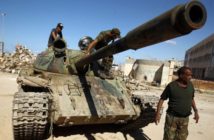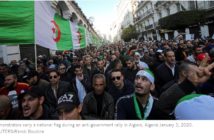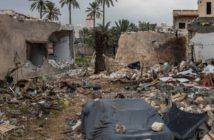Ahram Weekly
Though its monarchy moved fast to pre-empt the Arab Spring, all signs say that the conditions that sparked Arab uprisings elsewhere are still evident and mounting in Morocco, writes Rachid Yalouh
The Moroccan regime was quick to pre-empt the fallout from the revolutions of the Arab Spring. Two weeks after the 20 February protest movement began, King Mohamed VI called for the amendment of the constitution, in accordance with certain conditions and guidelines that he set out in his speech of 9 March. The process brought the Moroccan Justice and Development Party (JDP), an Islamist-oriented party, into government at the head of a fragile coalition and an alliance whose general framework and political horizons were set by the palace.
The regime and its supporters had variously billed this course as a “safe route through the danger zone,” a “third path”, “reform in the framework of stability”, and “the beginning of democratic transformation”. However, do developments over the past two years bear these slogans out?
The approximately four-century old Moroccan monarchical order is an anomaly among Arab regimes. Moroccans refer to it as “the vault”. Derived from the notion of the repository where the king stored revenues collected from taxes and other levies legitimate or otherwise, the term came to refer to the ruling elite. If, traditionally, this comprised the royal court, dignitaries and large landowners, it eventually extended to include tribal chieftains, senior military officials, security chiefs and other members of the executive establishment. In recent decades, the contours of the vault have grown somewhat ambiguous. For example, the cabinet is no longer a part of this sanctum. Among the progressive intelligentsia and political circles, the term has acquired a derogatory connotation since it has also come to be associated with antiquated modes of governance and resistance to democratic liberties and practices. In Morocco, the king acts as the “Leader of the Faithful” and monopolises all religious, secular and military powers. His authorities enable him to intervene in the legislature and to control about 60 per cent of the national economy. He has demonstrated a flare for using a democratic facade for his despotism.
Morocco’s long history testifies to the regime’s deftness in manipulating cultural, tribal, religious and political groupings in order to neutralise and tame opponents. A prime example occurred in 1999 when the palace allowed opposition forces to form a government in exchange for ensuring a smooth succession for Mohamed VI. A few years later, they woke up to the reality that they had been the pawns in a complicated game of artificial democracy that the late king Hassan II had called “democratic rotation”. By the end of the next decade, the parties that had been involved in that game crumbled as a result of their involvement in the perpetuation and manufacture of despotism and corruption without, moreover, having contributed positively to the improvement of the social and economic circumstances of the people or to altering in any substantial way the nature of the regime.
It is little wonder, therefore, that Moroccans see little new in the regime’s latest manoeuvre. Apart from the parties that stood to benefit from it directly, the prevailing feeling among Moroccan public opinion was that the constitutional amendment and its attendant measures was an escape forward that merely deferred resolutions to the country’s problems. Turnout for the referendum on the constitution attested to the general attitude. Only 15 per cent of eligible voters went to the polls, and this in spite of the fact that the king had delivered two public addresses in order to urge people to the polls to vote “yes” on the constitution.
It is important to note, here, that the parties that supported this course of pre-emptive containment were opposed to the 20 February movement. Like pro-regime forces elsewhere in the countries of the Arab Spring, these parties had no place on their agendas for meaningful political reform or a serious drive to uproot corruption. They were not interested in a revamping of the constitution. However, the requirements of the containment game and the exigencies of the moment obliged them to play along. So, they too began to spout some of the slogans of the protest movement, but with the purpose of diffusing the energies of that movement and ultimately reinforcing the absolute hegemony of the palace. In fact, some left wing parties and individuals, which insisted in participating in the constitutional commission appointed by the king, proved among the keenest to enhance the powers and scope of authority of the monarch in the constitution, as was admitted by Mohamed Al-Touzi, a member of the constitutional commission, in interview with radio France Culture.
As this suggests, the Moroccan regime’s ability to contain opposition is, in large measure, the product of the willingness of cultural and political elites to be co-opted, in flagrant contradiction to the slogans they recite. To this we can add a salient feature of the real opposition that is genuinely determined to bring change to Morocco. The foremost exponent of this opposition is the Al-Adl wal-Ihsan (Justice and Charity) association. The largest political Islamist group in Morocco, it draws on a Sufi background and training, and enjoys a large grassroots base, strong organisation and full independence from connections abroad. It rejects the king’s claim to leadership of the faithful and conditional participation in the political process. Rather than “revolution”, it espouses the notion of “qawma”, as developed by the group’s founder, Sheikh Abdel-Salam Yassine, which holds that any popular movement that seeks to overthrow a regime must have a clear conception of its goals, remain peaceful in nature, avoid disorder and improvisation, and promote the values of benevolence and participation of all vital and liberating forces in society. Essentially, it is a gradualist approach since it involves human development and time as the chief engines for change. Therefore, the group is in no hurry to topple the regime, largely because it is averse to precipitous action with incalculable consequences, which is why it withdrew from the 20 February movement.
Since the monarchical reform initiative, there have been other political, economic and social evidence of the regime’s policy of containment. One of the strongest was the manner in which Abdel-Illah Benkirane was appointed prime minister in the small town of Midlet, to which Benkirane was summoned while the king was there on a short visit. This was a huge precedent for a country in which the sovereign is normally girded with a highly sensitive thicket of protocol and symbolism. Analysts read the symbols here as a brief and succinct message from the monarch to the effect that anything that appears to promote the democratic transformation and Arab Spring in Morocco is an illusion. The interpretation was confirmed by a series of appointments of royal advisors, prime among whom was the king’s friend Fouad Ali Al-Himma, who Benkirane himself had described as “the corrupter”. On numerous occasions, these advisors have confirmed that they are active players in government planning and executive decisions, in spite of the fact that the constitution makes no mention of a position called “advisor to the king”.
Rather than relaxing its grip on the political sphere, the palace has tightened it by means of its direct control over the activities of JDP cabinet members. For example, Minister of Media and Communications Mustafa Al-Khalfi was compelled to abandon his television reform programme because the king summoned him, together with the prime minister, and instructed him to hand over the project, which had stirred considerable debate between the JDP and secular forces, to the Ministry of Housing.
The hegemony and immunity of the monarch is evident in many other ways. The palace has continued to promote monarchical rituals such as kneeling before the king and kissing his hand. When a group of youth protested against such degrading practices in front of the parliament building last summer, they were greeted with the heavy hand of security forces.
The parliament is unable to discuss the budget of the royal court, which is not included in the national budget. Yet, these expenses cost the Moroccan people more than $700,000 a day, which is to say more than European countries spend on their respective royal houses or than France spends on the Elysée Palace. Once again, young protesters against this non-discussable and non-negotiable budgetary allocation were beaten and arrested by security forces.
Little has improved in other domains during the past year. Benkirane once complained that there are forces opposed to change and reform that are determined to undermine his programmes. He described them as “crocodiles and demons”. During his electoral campaign he had pledged to combat corruption and tyranny. But since becoming prime minister he has stressed that he would not hunt down previous offenders. “Let bygones be bygones,” he said, although there are government reports and files that are waiting to be handed over to judicial authorities for investigation.
The past year also brought a wave of arrests, trials and human rights violations against activists from the 20 February movement, the Justice and Charity association and other peaceful opposition forces.
If international human rights reports for 2012 paint a grim portrait of the rights situation in Morocco, international economic reports paint a bleak picture of the economic situation. The national trade deficit has sunk to levels unprecedented since the structural adjustment programmes dictated by the IMF were put into effect in the 1980s. In October 2012, the trade deficit reached 163.9 billion Moroccan Dirhams (MAD), 10 per cent higher than it stood the previous year at that time.
In August, the IMF opened a $6.2 billion, two-year precautionary credit line for Morocco accompanied by a strong exhortation to reform the subsidy system. In October, Standard and Poor’s Ratings Services cautioned that it might lower Morocco’s credit rating from investment grade while Moroccan economic experts warned that foreign currency reserves could only cover imports for four months. The king quickly arranged a tour of Gulf countries to solicit financial assistance so as to stave of the spectre of economic collapse.
UN human development indicators place Morocco at 130th out of 187th countries, with an illiteracy rate of 56 per cent out of its population of 33 million. The government anticipates a 3.4 per cent economic growth this year and a 4.5 per cent growth rate next year, and it claims that it will cut the budget deficit to 4.8 per cent of GDP. However, economic experts maintain that these projections are extremely optimistic in light of the decline in essential sectors such as tourism, which has dropped by four per cent, and remittances from Moroccans abroad, which have fallen by 3.1 per cent, and in light of rising prices of food and raw materials in the international market.
In sum, the current situation of Morocco nearly two years after the 20 February movement is alarming. With political horizons closed due to the palace’s hegemony over all areas of economic and political life, general lack of confidence in self-serving political parties that play the markets of gain and corruption, and mounting unemployment, poverty and social injustice, the future looks dark and hazy. A year’s worth of pre-emption touted as the beginning of reform and democratic transition has only protracted the grave structural dilemmas that need to be addressed. The aspirations and demands that the brought the Moroccan people into the streets and squares in 2011 are more pressing than ever, which makes it highly likely that the forthcoming period will bring unprecedented waves of unrest.
The writer is a senior researcher at the Arab Centre for Research and Policy Studies in Doha, Qatar.
.






